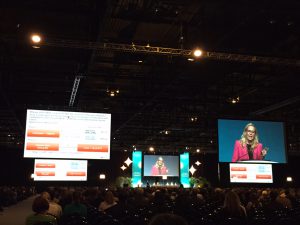Thoughts on ASCO 2015
 Had the opportunity to attend ASCO last week with a few goals in mind:
Had the opportunity to attend ASCO last week with a few goals in mind:
- Get updates on current trends in oncology management as oncologists are common clients of pathologists and laboratories.
- Spend some time in the exhibit area to see how personalized medicine is being marketed to oncologists.
- Assess what is happening in the genomics/proteomics space as it relates to treatment of patients and how those technogies are being marketed to oncologists.
 What I came away with I can state in 2 words: Liquid biopsy or #liquidbiopsy if you want to get it down to 1 word.
What I came away with I can state in 2 words: Liquid biopsy or #liquidbiopsy if you want to get it down to 1 word.
If you take away the sizeable pharmaceutical booths the exhibit hall was left with dozens of companies selling a lab developed test or laboratory companies selling LDTs for any number of gene profiles across a wide disease spectrum. 19-gene, 40-gene, 50-gene panels to better assess appropriate therapies and predict response to therapy. Others were looking at specific mutations or protein expression.
What I think has changed is the #liquidbiopsy approach using blood or urine to do this in near real-time not only for drug-effect monitoring but also for screening, recurrence detection and effect of therapy using without need for off real-time biopsies or when biopsy/re-biopsy may not be suitable.
It is clear that liquid biopsies have a lot of potential, the only problem is that there aren’t any definitive studies available proving that they do present a benefit to patients as well as which kind are best for which conditions and who should get them and when.
At the moment, liquid biopsies are recommended when a tissue biopsy is difficult, such as in the case of lung cancer, or when the original site of the disease is unknown. As a test, a liquid biopsy is a simpler way of letting physicians explore another avenue of treatment when current therapies are no longer working for a patient.
Early versions looked for whole tumor cells in blood. Newer ones look for free-floating cancer DNA, enabling gene profiling to see what mutations drive the cancer.
And reimbursement remains an issue.
Whether liquid biopsies will be cost-effective is unknown. The promise of liquid biopsies is that they can be done periodically to monitor care, but more tests means more cost. They may save other costs, though. A traditional lung biopsy is thousands of dollars. Money could be saved by skipping cancer drugs that ultimately don’t work.
Still, patients do better when drugs are matched to their tumors, and liquid biopsies may give a practical way to do that more often.
Ultimately, liquid biopsies might offer a way to screen for cancer besides the mammograms, colonoscopies and other methods used now.
That raises even more questions, including when to call something “cancer” and whether it needs treatment if there are only abnormal cells in the blood.
I think this much we know – the tumor is the symptom. The disease is the DNA. Why not look at the DNA in blood or urine for screening, disease management and therapeutic monitoring?
Comments (1)
Ole Eichhorn


































Hi Keith what is the means of assay for liquid biopsies? Are they quantified in a common way, or are they all different?